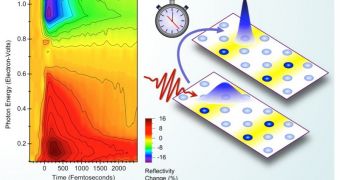A group of investigators from the US Department of Energy's (DOE) Lawrence Berkeley National Laboratory (Berkeley Lab) was recently able to explain the origins of a phenomenon called stripe phase, which occurs in a particular class of materials called superconductors.
The research could set the stage for bringing superconductivity-based devices and applications closer to reality. This state, which allows certain materials to carry electricity without loss or resistance, can now be obtained only at very low temperatures.
The goal in this area of physics and materials science is to develop a superconducting material that can retain its property at room temperature. Progress in this field is slow, as researchers have been struggling for decades to understand how materials gain this amazing property.
A cohesive theory of superconductivity is difficult to produce due to the extremely complex physics involved. In the new study, the Berkeley Lab team shed some light on one of the components of superconductivity, an effort that may lead to other advancements as well.
The research was conducted on a model compound and revealed how the stripe phase forms. During this phase, which is apparently tightly linked to the emergence of superconductivity, electrons tend to concentrate in stripes within the target material.
“We’re trying to understand nanoscale order and how that determines material properties such as superconductivity. Using ultrafast optical techniques, we are able to observe how charge stripes start to form on a time scale of hundreds of femtoseconds,” says scientist Robert Kaindl.
The expert, who holds an appointment as a physicist with the Materials Sciences Division at Berkeley Lab, explains that a femtosecond lasts for just one millionth of one billionth of a second. He and his team analyzed the stripe phase phenomenon in a material called strontium-doped lanthanum nickelate.
To investigate the interactions between electrons in this material, the team used extremely powerful microscope, which rely on femtosecond lasers to create very short time frame snapshots of electron arrangements. LSNO was selected as a test material because it does not exhibit superconductivity.
Additional X-ray scattering and the infrared reflectance data were obtained by using the Advanced Light Source (ALS) at Berkeley Lab. The investigation was funded by the DOE through its Office of Science.

 14 DAY TRIAL //
14 DAY TRIAL //